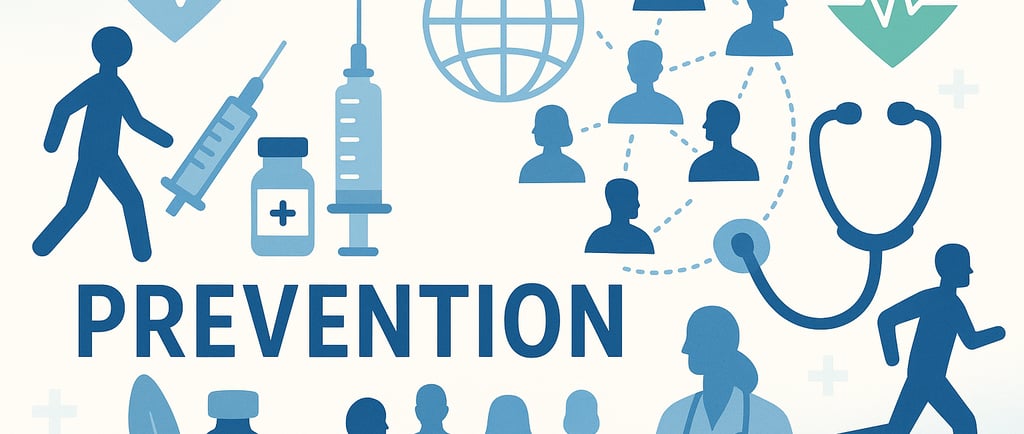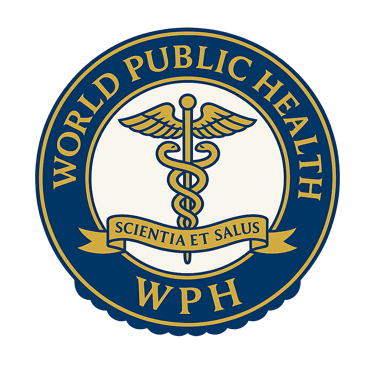The Power of Preventive Medicine: Redefining the Future of Care
By David Adeyemo, World Public Health
4/30/20243 min read


Introduction
The foundation of public health lies in prevention. Preventive medicine focuses on stopping disease before it begins, saving both lives and resources. In a world where chronic diseases, mental health challenges, and infectious outbreaks continue to rise, prevention offers the clearest path to long-term health security.
For decades, health systems have invested heavily in treatment rather than prevention. Yet evidence shows that focusing on early detection, education, and behavior change has far greater benefits for both individuals and societies. The shift toward prevention is not just a medical necessity; it is a moral and economic imperative.
The Value of Prevention in Public Health
Prevention reduces suffering, lowers costs, and strengthens communities. Every dollar spent on preventive programs such as immunization, clean water, and health education saves many times more in treatment expenses. Vaccination campaigns have eliminated smallpox and dramatically reduced diseases like polio and measles.
Simple interventions, such as promoting handwashing, improving sanitation, and encouraging physical activity, have been shown to prevent millions of premature deaths. Preventive care also reduces hospital overcrowding and improves quality of life. Healthier populations are more productive, resilient, and capable of contributing to social and economic development.
Screening and Early Detection
Early detection is one of the strongest tools in preventive medicine. Screening for conditions such as hypertension, diabetes, and cancer allows for early treatment and reduces complications. Public awareness campaigns that encourage regular checkups and self-examinations help identify problems before they become life-threatening.
Governments and health organizations are increasingly integrating preventive screening into primary healthcare systems. When communities have access to early detection programs, disease outcomes improve dramatically, especially in low- and middle-income regions where curative resources are limited.
Health Education and Behavior Change
Knowledge remains one of the most powerful medicines. Educating communities about nutrition, exercise, and substance avoidance has long-term benefits that extend across generations. Public health campaigns that promote safe sexual practices, balanced diets, and vaccination create cultural habits that support wellness.
Schools, workplaces, and religious institutions play vital roles in spreading accurate health information. In many parts of the world, misinformation about vaccines or nutrition continues to undermine progress. Strengthening public trust through transparent communication is therefore a key pillar of effective preventive health.
Technology and Digital Innovation
Digital health has transformed the delivery of preventive care. Mobile applications, wearable devices, and telemedicine platforms now allow people to track blood pressure, glucose levels, and heart rate in real time. Artificial intelligence supports predictive analytics, helping health systems anticipate disease patterns and allocate resources more effectively.
Technology also makes preventive care more inclusive. In rural areas where access to clinics is limited, digital tools extend the reach of health education and monitoring. Combining traditional community-based strategies with modern data systems will define the next generation of prevention.
Global Perspectives and Policy Integration
The WHO and CDC emphasize that prevention must be central to all national health policies. Universal health coverage cannot succeed without preventive care at its core. Countries that prioritize prevention see reduced healthcare costs and longer life expectancy.
World Public Health advocates for policies that link prevention with equity. This includes funding for vaccination programs, community health education, and support for local research. Strengthening prevention at the policy level ensures that future generations inherit systems built on sustainability rather than reaction.
The Path Forward
The future of global health depends on preventive action.
Awareness: Increase public understanding of risk factors and healthy lifestyles.
Access: Ensure every community can reach preventive services such as vaccines and screenings.
Accountability: Build health systems that measure and reward prevention, not just treatment.
When prevention becomes the cornerstone of health systems, societies will move from managing illness to cultivating wellness.
Conclusion
Preventive medicine is the bridge between health and hope. It shifts focus from hospitals to homes, from crisis to continuity, and from short-term relief to long-term resilience. By investing in prevention, nations build stronger populations and healthier economies. As WHO, CDC, and World Public Health continue to promote preventive action, one truth remains clear: the most powerful medicine is the one that stops disease before it begins.


About the Author:
David Adeyemo, RN, MSN, MPA, MS-HRM, CPH, PhD(c), is the Founder and President of World Public Health. He is a public health nurse, Army medical officer, and global health scholar dedicated to advancing public health leadership and equity worldwide.
